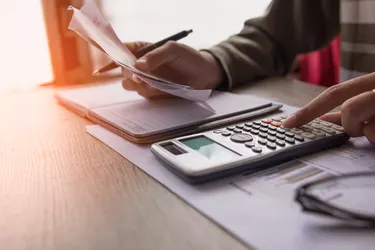When you're investing, especially if you're a day trader, you can measure how well or how poorly you've done based on the gains or losses in your portfolio over the course of a day. But, there are multiple ways to measure a return, and knowing the different formulas can help you keep tabs on how your investments are performing each day.

Video of the Day
Calculating Your Actual Gain or Loss
To figure your actual gain or loss, as measured in dollars and cents, subtract the starting price of the stock from the closing price. Then, multiply the result by the number of shares you owe. For example, say you have 200 shares of RT Corp and the stock starts the day at $27 and ends at $25. Subtract $27 from $25 to get negative $2, meaning you had a $2 loss per share for the day. Then, because you own 200 shares, multiply negative $2 by 200 to get negative $400, meaning your daily return was a $400 loss.
Video of the Day
Calculating Daily Return as a Percentage
Measuring your daily return as a percentage will account for the relative value of different investments. For example, if you lose $1 on a $100 stock, it's not a huge portion of the value. But, if you lose $1 on a $10 stock, that's a much bigger deal. To calculate your daily return as a percentage, perform the same first step: subtract the opening price from the closing price. Then, divide the result by the opening price. Finally, multiply the result by 100 to convert to a percentage.
For example, if the stock opened at $27 and closed at $25, subtract $27 from $25 to get negative $2. Then, divide negative $2 by $27 to get 0.074. Finally, multiply 0.074 by 100 to find that your daily return on the investment is negative 7.4 percent.
Dividend Considerations
Usually, the dividend policy of the company won't affect your daily return calculation. Even if a company pays a quarterly dividend, meaning four dividends per year, that's only four days of the entire year that would be affected. However, it's not the date the dividend is paid that affects the daily return. Instead, it's the ex-dividend date, which is the date on which the stock starts trading without the right to receive the next dividend.
For example, a company may announce a dividend with a payment date of June 15 and an ex-dividend date of June 10. If you buy the stock on June 9, you have the right to receive the June 15 dividend. But, if you buy it on June 10 or later, you won't receive the June 15 dividend. As a result, the price of the stock usually falls on the ex-dividend date by an amount equal to the expected dividend return. For example, if a stock were paying a $1 dividend, the stock price would fall about $1 — all else being equal — on the ex-dividend date. So, when you calculate the daily return for that stock, add $1 to your daily return because you'll receive that as a dividend.